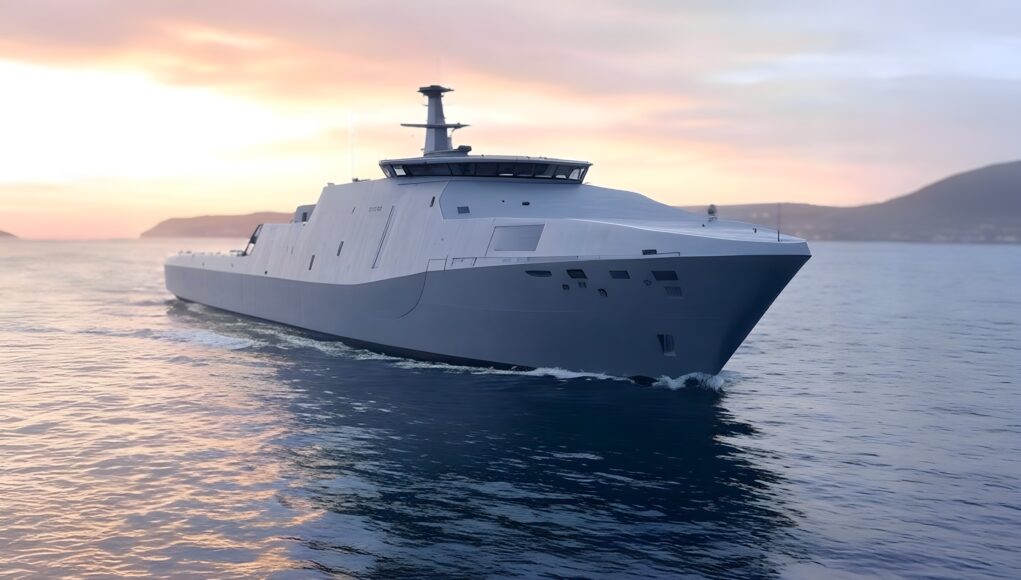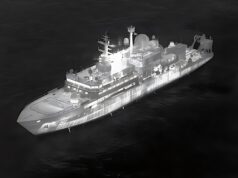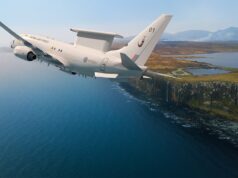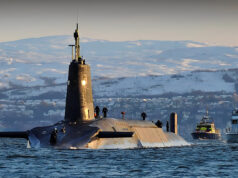The Royal Navy’s Type 32 frigate was once billed as a key part of the future fleet. First announced in 2020 with little prior warning, it was positioned as a general-purpose escort and, more intriguingly, as a platform to support uncrewed and autonomous systems.
Since then, the project has drifted through the early concept phase, never quite cancelled, but never fully committed to either. In the background, financial pressures have grown, and new strategies are due.
This article is the opinion of the author and not necessarily that of the UK Defence Journal. If you would like to submit your own article on this topic or any other, please see our submission guidelines.
Whether the Type 32 ever becomes more than a design study will depend in large part on the outcome of the upcoming Defence Investment Plan and broader decisions about the size and shape of the fleet.
The idea behind Type 32 was always loosely defined. When then-Prime Minister Boris Johnson unveiled the programme in 2020, it came with little detail beyond a promise to grow the escort fleet and reinvest in British shipbuilding. The 2021 Integrated Review and Defence Command Paper later described the ships as general-purpose frigates designed to protect territorial waters, provide forward presence, and support the new Littoral Response Groups.
Gradually, the discussion shifted. In speeches, ministerial answers and shipbuilding strategy documents, the Type 32 started to be described as something more experimental. In 2022, the refreshed National Shipbuilding Strategy said it would likely be “the first of a new generation of warships with a focus on hosting and operating autonomous onboard systems”. Jeremy Quin, then Minister for Defence Procurement, described it as a platform intended to operate uncrewed systems to support anti-submarine warfare and mine countermeasures.
Industry took note. BAE Systems proposed an “Adaptable Strike Frigate” with modular mission bays and space for drones, while Babcock floated a stretched version of its Arrowhead 140 design with increased capacity for boats, payloads and containerised systems. Both aimed to align with a vision of the Type 32 as a flexible platform that could deploy uncrewed surface and subsurface vessels for roles such as minehunting or shallow-water surveillance.
If it does proceed, the Type 32 is likely to sit somewhere between the high-end Type 26 and the more affordable Type 31. It would not be a full-spectrum warfighting platform in the mould of a destroyer or advanced ASW frigate, but rather a multi-role vessel tailored to persistent presence and support functions.
Possible roles include:
- Hosting mine countermeasures drones such as RNMB Apollo and future MMCM variants
- Supporting littoral operations and acting as an escort to amphibious groups
- Launching and recovering uncrewed aerial and sub-surface systems
- Contributing to anti-submarine operations in coastal or shallow waters using off-board sensors
- General patrol and forward presence in lower-threat environments
This profile matches the Royal Navy’s stated need for more flexible, affordable ships to free up its more advanced assets. With the surface fleet stretched thin and escort numbers at a historic low, additional hulls would help cover both home waters and overseas deployments.
A Promise Without a Plan
Despite this operational logic, the programme has stalled. In the previous year, the National Audit Office reported that the Type 32 had been removed from the funded Equipment Plan due to affordability concerns. It also revealed that other naval projects, including the Multi-Role Support Ship and Type 83 destroyer, were beyond current funding limits. The following year’s NAO report stated that the Ministry of Defence was facing a £16.9 billion shortfall in its equipment programme, and that new warships collectively accounted for nearly £6 billion in unallocated costs.
Although ministers continue to describe the Type 32 as a future ambition, the Navy has no current funding line for it. The 2023 Defence Secretary, Ben Wallace, said the ship would not be procured until the 2030s at the earliest, and that work was still underway to define what it would be. In a later response to Parliament, the Minister for Defence Procurement confirmed the ship was still in the concept phase and that decisions on its future would be taken as part of broader strategic reviews.
The upcoming Defence Investment Plan, expected in late 2025, is now seen as the pivotal moment. Designed to bring transparency and predictability to long-term defence spending, the DIP will lay out how the government intends to balance current programmes, industrial priorities and emerging threats. It will also attempt to reconcile the defence budget with the ambitions of the Integrated Review.
If Type 32 is not included in that plan, or if its funding is not ringfenced alongside other major naval projects, it is difficult to see how the ship could proceed.
Industry Expectations and Political Promises
From an industrial point of view, Type 32 was meant to help maintain momentum. The government’s shipbuilding strategy highlighted the need for a consistent pipeline of orders to avoid gaps in work and preserve skills. With the Type 31 frigates expected to complete around 2030, the plan was for Type 32 to follow immediately after, making use of the same workforce and design knowledge.
Shipyards such as Babcock’s Rosyth facility had counted on the programme as a likely follow-on to the Type 31. If the contract does not materialise, there will be political questions about regional investment and levelling-up commitments. The programme has also been used in ministerial statements to showcase long-term support for British shipbuilding. Quietly shelving it may not go unnoticed.
What Happens Next?
The Defence Investment Plan will effectively determine whether Type 32 goes ahead. So far, the concept has been allowed to remain on paper, with little real-world commitment. That could change if the Plan allocates funding and provides a clear timeline for assessment, design and procurement.
If not, the ship may linger in a grey zone for years, overshadowed by higher-priority programmes such as Type 83, Fleet Solid Support, and Multi-Role Strike Ships. With costs rising across the defence portfolio and Treasury pressure mounting, the Navy may be forced to make hard choices. Delaying or dropping Type 32 remains a very real possibility.
Whatever the outcome, the Royal Navy’s interest in uncrewed systems is not going away. Autonomous capabilities are already being introduced across the fleet, including on auxiliary ships and offshore support vessels. What the Type 32 offered was a chance to bring those technologies into the heart of a new warship. That idea still holds strategic value. Whether it can be made affordable in the current climate is the harder question.














There are currently a lot of distractions re new system… it would be a pity if drones and other unmanned systems were to cause the government to lose sight of the basics. We need, if not a Type 32, then at least an equivalent. However, that equivalent could be a system with minimal crew numbers… if drone/AI technologies keep going as they are, why not a Type 32 sized vessel with a crew of 10 -30? That, to me, is a reason why Type 32 could prove obsolescent before it enters service.
But we need something. Apart from anything else, we need to maintain production capacity. We also need to increase the size of the fleet. For both these needs to be met then we still need Type32 or similar.
It was always a press-release without a budget or a plan (Typical Boris Johnson era announcement).
Just cancel it, save the hassle and cost of designing, testing and operating THREE different frigate designs at the same time, and commit to a second batch of T31 – gaining all the benefits of scale from a larger order and reaffirming faith in the the T31/Arrowhead design for export sales. If you want ‘drone mother ship’ or whatever, then do a different fit-out of the basic T31 hull.
Sigh
You realise we have no money for any new frigates, no matter what we call it
Apart from the eight T26 and five T31 currently in build, of course….
If we’re stopping at 13 new frigates, then all the more reason to stop pretending, formally cancel T32 and release staff for other things. If the goal is to expand the number of escorts (and that’s what has been stated) then best to do so as efficiently as possible.
There is always money for government priorities.. when HMG says there is no funding available what HMG means is they have other priorities.. the reality of government spending is an extra 4-5 type 31s ordered and paid for over a 5 year period is very small beer.
Hugo, Latest data– debt to GDP is 95%ish. And gross National debt of less than 3 trillion. Much, much better than the situation across the Pond. And our big ally only put 10%?? tariffs on UK, or has it changed again. Tariffs are wonderful, they are a consumption tax but don’t tell.
The type 32 warship do not cost very much, right?? UK can afford them.
After all, one of these days the Russian navy will come out of hiding from Ukrainian drones and we must be ready.
Boris announcing plans for a massive project without considering the cost or reality, doesn’t sound like him. He would never come up with a roundabout under the Irish sea or a floating airport in the thamas or well a dozen other schemes.
To be fair not sure the navy would really want yet another type of escort. T45/t26/t31/river2 already means little room for savings through common design or equipment. If they find the money better to focus on extra t31 or 26 or to fit out the river2 so they could actually do something useful in a war situation.
Completely agree. A batch 2 T31 with modest improvements would be able to do 90% of what is proposed for T32, would be far cheaper and would maintain the skills at Rosyth.
Quite agree with you.
Perhaps they should put T32 on hold for now and order more T31 – the RN badly needs more escorts.
If they are looking for money-saving suggestions, here is one: refit the remaining Bay-class auxiliaries as the first three MRSS. Strip them down to the weather deck and build new superstructure, including a hangar for multiple helicopters, and fit them out with similar sensor and weapons fit to T31. Yes, there are disadvantages to doing this, but when needs must…
Refitting the bay class? Seriously?
I didn’t say it was a great suggestion, but it seems the RN is in danger of seeing the MRSS axed for budget reasons or having it pushed back to the late 2030s.
I don’t think things are so desperate that we need to refurbish the Bays. Argus is toast and the 2 LPDs have gone. The original ‘up to 6’ MRSS program could evolve into 3 x large 20k+ LPDs + 3x 40k ton FSS (each with 2 spot flight decks) – Ellidas without well deck. In this way you ‘create’ 3 frigate hulls. The fleet would get a further 3 frigates if the batch 1 Rivers were replaced by ‘patrol frigates’ i.e. Type 31. The Arrowhead 140 is a large ship with lots of potential for say, a bigger mission bay for UUV drones which would I suspect be the way to provide ASW capability in shallow waters. So I see an increase of 6 in frigate numbers as enfirely feasible and affordable.
If the future of the RM is smaller company scale operations, the T32 could be a flexible platform capable of frigate duties and the MRSS role. T31 could be an affordable base platform , larger than the twin role Absalon class.
We don’t know the current state of the 10 year equipment plan. The last one, published in 2023, had swung back into shortfall largely because the RN had included costs of unapproved programmes- T32, T83, FSS, MRSS and FAD( together with a big increase in the nuclear budget to cover AUKUS.)
MRSS is a large ship, not a frigate, judging by recent concepts
I remember the ” large non complex warships” description. But it hasn’t been mentioned for a while. Do we really need large for company sized ops? Can we afford MRSS and additional escorts?
The most recent imagery suggests a large ship, as does the NN interview with the RN official in charge of the programme.
https://www.navalnews.com/wp-content/uploads/2025/06/MRSS-CC-MoD-scaled.jpg
https://www.navalnewscom/event-news/cne-2025/2025/06/royal-navy-details-mrss-requirements-and-challenges/
Removed the dot between ‘news’ and ‘com’ to post the link, as the other got moderated.
A second batch of T31 is a no brainer to me but fitted with the CIP upgrades from the start. A 32 cell Mk 41 for TLAM and quad packed CAAM plus NSM. If the Royal Marines and amphibious ops come back in fashion which with the First Sea Lord being a Royal Marine it might ( although personally and sadly I doubt) then NGFS might also make a come back so you could swop out the 57mm in favour of a five inch gun . Speaking to a former frigate skipper pal of mine he said he couldn’t imagine being a frigate driver without any idea of what is going on under the sea so I would also add a hull mounted sonar for which the basic T31 hull form was designed to include and possibly provision for some form of TAS, possibly of a CAPTAS type and to keep down initial build cost fitted for not with.
We’re not even sure if T31 is getting mk41 but you want to make a more expensive frigate to expand the fleet
Oh yeah and to save political face you could always call it a Type 32 😁👎🇬🇧
So as the article says, T32 was meant to be midway between T26 and T31 in capability, an adaptable multi-role frigate. Well, seeing as the T31 project seems to be going well, then why not just buy a second batch T31 and this time arm it properly – give it a 5 inch gun, a 32 cell VLS, the future anti-ship missile and a containerised towed sonar. Could order 10, or even 12, and sell on the original T31s as replacements become available.
Spending the money on actual ships would be far better value for money than spending it on fantasy designs that can never be produced.
Why the five-inch gun? There’s precious little that it can do that the smaller 57mm cannot in the modern battlespace.
Naval gunfire support for amphibious ops.
Most analysts are suggesting that the NGFS requirement will be pretty irrelevant into the future, given the rapid proliferation of shore-based anti-ship weaponry. Operating close to the shore of a contested coastline will be suicide.
USN have been using 127mm (5”) to knock out drones in the Red Sea. It is easier to build smart rounds into larger calibres. They also have much longer range. Ammunition like Volcano take 127mm out to 80km, or a 76mm out to 40km. There are ATGM which can fire out of 105 & 120mm tank guns. These things exist. Why not naval equivalent? NGFS has limitations against a modern adversary with a heavy defended coastline. However, not all adversaries are modern, not all modern have massive amounts of land based AShM or high end drones or guided long range land based artillery/rockets. If one beach is highly defended, find another one. D-Day type opposed landings are something all militaries will try hard to avoid. If it is unsafe to use NGFS, bomb the hell out of them til it is.
It seems as though ordering an extra two or three frigates from Babcock would be a cheap and straightforward improvement to combat mass. Crewing is set to improve in the future, so that should become less of an issue. Similarly, the price of each individual warship of the class should come down with each new ship added to the order. The RN will lose its forward deployed Batch II River-class ships soon as they replace the Batch I in the home waters – these proposed extra Type 31 frigates could replace those vessels.
I’m not entirely sure that the Type 31 requires the Mk41 urgently. Doubling the Sea Ceptor count in the design would be an easier change to make and would significantly improve its air defence capability. I’d rather see the money spent on sonar.
There is nowhere for a sonar
Firstly, is there any evidence to support your claim?
Secondly, assuming you’re correct, a containerised system could be used. A hull-mounted system could be fitted – the IH-class had a bow-mounted sonar. Either would be an improvement over its current fit.
Additionally, didn’t Babcock advertise a sonar-equipped variant as an option?
My evidence? Go look up type 31 bow
Are you strapping the container to the bottom of the ship? There is no bow done for a sonar, it’s solid steel
Containers could be placed into areas of the ship specifically designed to be left empty for future upgrades. A TAS could be used. Babcock have advertised that the design could be given an improved ASW performance through additional sonar and quieting, so the potential is clearly there.
If you’re willing to spend the money, the solid bow could be replaced, although the practicalities of such an operation are debatable.
“solid steel”- don’t be so effing ridiculous.
Funny how the Polish variant of the Arrowhead will have a towed array
It isn’t solid steel.
But there is no sole plate for a sonar to be attached to.
A sonar requires the upper part of the bow to be steel with the sole plate. The lower part of the bow is then fibreglass for sonar propagation.
The polish AH140 has a sonar inside the bow dome and the dome is a separate chunk from the hull anyway, so there’s no reason why T31 couldn’t have its bow replaced and a sonar installed. Much larger changes have been made in refits before.
The dome is not a separate chunk on the UK type 31, there is no spaced reserved for a sonar, it’s a solid steel structure. They’re not going to cut off the entire bow just to put a sonar in
How did the Poles do it, then? That would be a massive change between the variants for very little reason, and there’s no justification from our perspective in replacing the AH140 ‘sonar-able’ dome with a metal lump.
Like I said, much bigger bits of metal bashing have been done before for less important reasons.
Theres plenty of reason to replace the sonar mounting area with a solid bow, cause were never gonna get one, and it means less internal spaces to be maintained and repainted.
The polish just used the original Iver Hutfeldt bow design
The plate the sonar mounts to would have to be incorporated into the structure.
It has to be very robust to deal with impact damage as well as damping resonance at very high power levels.
Certainly is there is a large mission bY space under the flight deck with space for up to eight standard ISO containers, would easily take a CAPTAS 4.
Its a container space with no access to the stern of the ship
There is actually , Venturer as she is currently configured will be equipped with a Type 2170 SSTD which comprises a winch, a towed acoustic sonar array , a processing cabinet , display consuls and ‘ launchers for expendable acoustic devices’ all of which make use of an access hatch opening in the stern of the ship. Your argument was there isn’t the space , there is ( this is a nearly 6,000 ton vessel) she already has a towed array system albeit limited at this current time and it would be relatively simple to make use to make use of this space if the money and will were there.
SSTD is not a VDS, it does not have the same equipment for deploying it into the water or even have a large enough rear hatch
Government problem “we haven’t enough escorts”
Government plan “we will build no more than the current type 23s in numbers.
Result – we will be in the same situation later down the line.
Genius.
I liked the idea of the fearless Class Multi-Role Ships. Basically felt like a merge of mrss and Type 32 in one ship.
Problems with introducing a third frigate are considerable.
We are just about broke as a nation. Claims that we are the 7th richest nation in the world are one-eyed, we are only so due to GDP per head x population. Virtually every country in western Europe has a higher standard of living than we do and more to spend on defence Pro rata.
The RN’s proposed acquisitions alreadt exceed its budget by miles. There is basically no cash to pay for MRSS, the second Proteus, anything more than 3 Stirling Castle MCMVs and the gap between financial reality and RN aspirations is now pretty massive – even before amyone says T32 FF.
Strategically, the new emphasis is going to be on NATO first and the air and land forces we are committed to providing but are singularly failing to do so. For instance, we are meant to provide a strategic reserve of 2 heavy divisions, meaning 6 armoured infantry brigade groups. We have just two to offer and they have almost no field artillery, sparse air defence, a tiny tank force, no counter-UAS weapons and a fleet of armoured vehicles 30, 40 and 50 years old. The priority here is pretty clear: first RAF fast jets the number of which have shrunk to minimalist proportions, then the land equipment for this UK corps for NATO.
Facing a pretty limited naval threat from Russia, the RN is strategically the least important service for the forseeable future. (Yes, we are an island and rely on international trade routes, but so many of our allies are islands or have much large littorals than we do, without feeling the need to send a flag-waving carrier group X,000 miles away from the NATO area.
More escorts would be great, along with more subs, corvettes, MCMVs and the rest. But financially, it’s not going to happen and strategically, it’s not a high priority in the new scheme of things..
What the RN could perhaps pitch for is a return to the original T31 plan. That was building the first batch as T31E, the E standing for escort. The idea was that they would be flogged off to overseas navies and replaced by more capable ones.
T31 is not wildly valuable as an out-of-area patrol frigate, because it has no dedicated ASW fitout and would be far too vulnerable to.attack from below the waves. Revert to the original plan, sell off the T31s and replace with a propetly armed T32, with a hull-mounted AESA radar, rafted engines and equipment, to make it less noisy in ASW mode, then you would have a useful addition to the fleet. It would be a good bit more expensive than a T31, but that is the price for having a capable general purpose frigate that can do all 3 roles – air defence, ASW and surface combat.
.
I couldn’t disagree more. The RN is and should continue to be the most important contribution of UK defence to Europe and NATO. The UK has no business getting into a slogging match of any kind in Europe, except in a home defence capacity or as a significant force multiplier for allies in the thick of it. That’s not to say we don’t have serious work to do, to both modernize and bring back the strength of the Army and RM, but not to such a degree that they could stand up to Russia alone in Norway, for example. Those days are gone.
Maintaining control of the waters is a significant challenge, and one that the UK is well-placed to take on (and benefit from).
How are you paying for 5 more somehow well equipped frigates when the T31 won’t even sell for its build price, besides the fact we need them till T26 is all in service
“Facing a pretty limited naval threat from Russia, the RN is strategically the least important service for the forseeable future. (Yes, we are an island and rely on international trade routes, but so many of our allies are islands or have much large littorals than we do, without feeling the need to send a flag-waving carrier group X,000 miles away from the NATO area.”
Nonetheless. The Russian Northern Fleet is growing, and in capability of new class of subs. It will become even a more of a challenge once the Ukraine War ends in a stalemate. A new Cold War will be with us again for a couple of decades. Don’t be surprised if the Ru. launches some cruise missile strikes from the Irish Sea, because we have very little conventional deterrence left! Restore the Royal Navy fleet to pre 2000 size!
Not really, if you look at the Northern Fleet the RN could probably take it on on it’s own, never mind without the rest of NATO supporting it. NATO has a ridiculous overmatch over the Russians in terms of Naval forces, the area the delta is the narrowest is Land Forces.
Agreed in full 👍
The only fly in that oil is China, a profoundly navalist power. If ( and it’s still an if) China and Russia snuggle up even closer then we could see..
1) Chinese’s naval operations in support of Russia.
2) China recapitalising the Russian navy with its industrial capability.
China has a scary naval industrial output and could recapitalise the Russian fleet in a few years.
The Russians have always put their SSNs & SSBNs first–everything revolves around protecting & enabling them. Building a blue water surface navy might have been something the Soviet economy of the 1960s or 70s could afford, but appears a luxury today. So it would seem land attack and ASW would be the top capabilities you’d invest in, regardless of how many, or of what class, ships you build.
The QE / PoW CSG is the Navy’s ultimate (non-nuclear) strike option, so ensuring its survival would seem to be Priority #1–after the CSG’s strike capabilities themselves, that is. And if we’re talking Russia, then “survival” means ASW first & foremost.
Time is running out rapidly for the remaining Type 23 frigates, so we cannot afford to sell off any new builds right now.
We know the T31s will eventually get Mk41 VLS, and that will give them access to more offensive weapons.
The only point I would partially agree on is that T31 should have bow sonar as a defensive measure.
Ahh the mythical type 32! Yes the only realistic affordable option is to try and get more type31s even just 3 more would greatly help the over stretched escort fleet we need to stop over complicating everything!
They free up the high end type 45 and type 26 to do what they are built to do protect the carriers and nuclear subs.
That’s what there purpose is doing general dogs body stuff you don’t want to waste a type 45 or t26 in doing hence they are cheaper and less crew as not as well equipped.
Are we missing the 3.5% GDP spend? Surely to goodness all things can get paid for now? Yes the government will struggle to find the money, but they’ve committed to it so that’s not the military issue. With no aim to increase the army by any substantial amount, there are only a handful of submarines to be paid for. They can’t build them fast, or multiple at the same time, so in every year that raised defence spending is sat there.
Surely we’re looking at extending the 26 batch, as well as exploring further type 32s? Or just continue the type 31s with a stronger defence loadout?
Reading these comments, its like the huge defence boost we’ve been granted never existed.
I truelly hope you are correct mate but on past experience with politicians on defence what they actually say is not what actually happens I’m afraid.
I may be wrong but I think the current lot were going to get to 2.5% by 2030 or finances permitting and 3% in the distant future.
The only thing that has changed that is Trump threatening to put tarrifs on everything that moves ha.
Once he is gone things may change we simply can’t borrow any more money we will have to either rase taxes or take money from welfare NHS budgets to pay for all this.
They don’t win elections for them thatsvwhy defence is more of an annoyance to them.
Don’t get me wrong I wish we had never heard of type 31 and we were only building the excellent type 26 think that was Cameron and Osborne doing that comedy act of 2010.
T32 is not the optimum MCM vessel
Presumably, the UK Defence Investment Plan (DIP), the successor to the Defence Equipment Plan, will provide significant insight into a realistic assessment of MoD acquisition plans/goals for the next ten years. Given a commitment by HMG to gradually increase defence funding, confidently predict the DIP will portray a defence reality somewhere on the continuum between utter despair and unbridled optimism often exhibited on this forum. Personal assessment is that the DIP will reflect a commitment to gradual rearmament of the UK, consistent w/ economic constraints. Any significant additional increase would probably be indicative of the outbreak of armed conflict. Believe the nadir of UK defence capabilities has already passed, and rearmament is both underway and relatively assured. The unpredictable forecast element will be how quickly the gathering storm clouds in the East develop into a full scale deluge. Everyone is entitled to make an independent judgement re where on the timeline leading to the next conflict we collectively currently reside.
No worries. You’re going to spend 5% of the GDP within a few short years. Lots of money for everything… Or somebody was lying?
I think the DIP will be generated by output from
Supreme
Head
Intelligence
Targeting
Old joke but couldn’t resist….
Need to properly equip the t31 first. It’s not far off the capabilities of a corvette! As things stand they can barely operate in a contested environment where there’s a subsurface threat. At the moment they’re floating coffins not far off the type 21 in terms of glaring weaknesses
Fleet Solid Support, and Multi-Role Strike Ships MUST be funded for and built in decent numbers
Better to produce instead two more units of Type 26 and Type 31 each, and reserve money for research and development on the coming type 83 ship.
As much as I would like to see the fleet expanded as much as possible I wonder whether money for projects like this should be used to bring weapons into use. It is all very well having a whole new fleet of frigates but their use will be limited if they don’t have the missiles to attack with. We’re still doing a lot of looking, listening and finding without being able to execute in the end. Someone described this as a kill chain with no kill.
Type 32 was slated to build fleet numbers… does this mean the government has abandoned the idea of increasing fleet numbers? Probably the RN is best building more T31s.This will save the expenses of designing a new skip class.
If Labour where to do badly in the Scottish elections next year, that could change things?
Sorry I am confused by Scottish politics, I thought Scotland were run by the SNP both in the Government and the Parliament….
Scotland has a devolved Parliament which has the power to make laws on certain areas. Other matters are reserved for the UK Government. Reserved matters include defence, national security, and foreign policy.
The shipyards are now mainly in Scotland, of course other components are manufactured across the UK.
Shipyards, become headline news, when further orders not forthcoming!
“It would not be a full-spectrum warfighting platform in the mould of a destroyer or advanced ASW frigate …”
If a nation has 2x CVs, the first priority is a fleet large enough to provide a full escort. Bringing a Danish corvette or Dutch frigate for a peacetime cruise to the Pacific is fun & all, but if you don’t the sovereign ability to protect your carrier, you don’t really have a true carrier capability. (Or at least the full operational capability of a carrier strike *group* and it’s only in *groups* that carriers operate.)
If there are enough surface combatants in the fleet to do the former, then sure . . . build other types of ships.
Obviously, the RN will need to operate warships independent of CSGs, but these do not need to be specially-built. A “multi-role vessel tailored to persistent presence and support functions” doesn’t save any money if they’re relatively useless for high opstempo modern war–even if they are cheaper per-unit-cost. Just ask the USN what it could be doing, in hindsight, with all the $$$ wasted on the LCS.
The proper balance between cost and capability would be to simply build the Type 32 in its original vision–a general ASuW ship–with room for adaptability & modularity built-in. It sounds like the fastest option is to work off the Type 31. There is modern precedence for a “good enough” design turning out to be excellent–the Virginia SSN. What today is touted as the “the world’s most advanced submarine” began life as the less expensive counterpart to the Seawolf class. Adaptability was central from Day 1. This enabled development of a “stretched” flight that better suits special missions / SOF.
This already sounds like a plan to create a more expensive second rate ship.
If there is no money committed towards it, that’s better than the alternative. If one has to choose, better to waste brain cells thinking or stressing over a hypothetical than waste actual monies. With the F-35, Tempest, and Type 26/31, real money has already been expended …
Since the Australians are getting the Japanese FFM (Mogami-class or derivatives), why not get something similar? The roles between the Mogami-class and what is described for the Type 32 in this article are very similar. Even if you don’t use the same hull, you can always share systems. A collaboration is also not out of the picture since the UK and Japan are already collaborating on Tempest.
Probably a good idea to get more exercises with the JMSDF. Getting to see how Japan’s FFM work with the Type 26 can benefit all three navies with no particular country footing the whole bill. Might even decide on how the Type 32 will look like.
The uncertain future of british armed forces. Few ships, few aircraft and few tanks , Only promises of increased military spending, but no new orders or funding for new projects. It’s all smoke and mirrors.
To this day I’m convinced it was a slip of the tongue and he meant the T-31 but doubled down…..
We still need to define exactly what a type 32 frigate is:
What is its role?
How would it differ from type 31 in capabilities?
What is the justification for buying it over adding more 31s to the fleet?